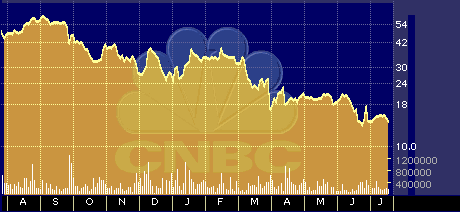
MIPS’s Stock Seen Heading Back Up
MIPS’s Stock Seen Heading Back Up
by Hal Plotkin
Silicon Valley Correspondent
“…we believe the stock will regain value as royalty streams begin generating an increasing portion of revenue for the company”
— Jennifer Smith, Dain Rauscher Wessels analyst
Several analysts say MIPS Technologies Inc.’s {MIPS} stock is likely to move up over the short term, thanks to strong demand for the company’s products from the makers of cable set-top boxes, personal digital assistants, game consoles and other consumer-electronics devices.
Warburg Dillon Read analyst Gregory Mischou, based in San Francisco, recently reiterated his “strong buy” recommendation on shares of MIPS, which have dipped somewhat in recent sessions.
“We feel confident in our [fiscal year 2001] projections, due to continued licensing momentum and upside potential in royalties from Sony’s Playstation 2,” Mischou wrote in a research note released on Dec. 21.
Mischou has a 12-month price target of 75 for the stock, which has been trading at about 52 lately, after falling back from a 52-week high of 69.

52-week performance chart for MIPS
MIPS TECHNOLOGIES INC (NNM:MIPS)
| Analyst pinions | Average Recommendation | Earnings Per Share | |||
| Strong Buy | 5 | This Week | 1.2 | Last Quarter | 0.13 |
| Buy | 1 | Surprise | 0.01 | ||
| Hold | 0 | Percent | 8.33% | ||
| Sell | 0 | Consensus EPS | |||
| Strong Sell | 0 | This Year’s | 0.72 | ||
| Next Year’s | 0.83 | ||||
MIPS TECHNOLOGIES INC – MIPS ranks 99 out of 99. It is in the Electronics/semiconductors industry.
Analyst Ratings compiled by Zacks
The Warburg Dillon Read analyst says concerns over reports of weakness in Nintendo 64 game-cartridge sales led to the recent decline in the stock price, following a strong rally over the previous few weeks. Last quarter, Nintendo 64 sales represented 49 percent of the company’s total revenue.
“Overall, we believe that software sales for Nintendo 64 are tracking as expected during the seasonally strong December quarter,” Mischou wrote. “New titles for Nintendo 64 are selling well, and the weakness is likely limited to older games. Therefore, we believe the selloff in the stock is well overblown.”
Dain Rauscher Wessels analyst Jennifer Smith, based in San Francisco, shares Mischou’s optimism about the stock, albeit with a lower six-month price target of 60 a share.
“While year-end profit-taking may result in short-term price erosion, we believe the stock will regain value as royalty streams begin generating an increasing portion of revenue for the company,” Smith wrote in a research report released on Dec. 23.
Smith’s price target of 60 is based on a 22 multiple times forward revenue which, she wrote is “at the low end of a comparison group of selected semiconductor intellectual property vendors.”
Mountain View, Calif.-based MIPS, a spinoff from Mountain View, Calif.-based Silicon Graphics Inc. {SGI}, designs and licenses high-performance semiconductors for digital-consumer and embedded-systems markets, such as set-top cable boxes, digital cameras, video-game systems, routers and handheld computing devices.
MIPS is in a particularly good position, analysts say, because the company primarily sells intellectual property in the form of designs to semiconductor manufacturers. That allows MIPS to benefit from burgeoning sales of semiconductors without having to make the massive investments in manufacturing plant and equipment, called “fabs”, that are needed by actual producers.
Rob Enderle, an analyst at Giga Information Group, based in San Jose, Calif., says the company’s focus on these markets allowed it to successfully pick up a ball drop by Intel Corp. {INTC} when it acquired a competing technology from Digital Equipment Corp. earlier this year.
“MIPS has been making some really nice inroads,” Enderle says. “Intel has been preoccupied with the desktop-computing, server and networking markets, so they’ve let that one languish. MIPS’s folks moved into the vacuum and are taking advantage of the situation.”
“Intel wants the same market, but they’re heavily distracted,” Enderle adds.
BancBoston Robertson Stephens analyst Dan Niles, based in San Francisco, also recently reiterated his “strong buy” rating on the stock.
“We expect the explosion of bandwidth and the demand for portable and embedded products to skyrocket in the next few years,” Niles wrote in a research note released on Dec. 20.
“The company has [also] seen significant success in the digital-TV market with set-top boxes from General Instrument {GIC}, Replay Networks and WebTV as well as from licensees targeting the set-top box market, such as Broadcom Corp. {BRCM}, QED and ESS Technology {ESST},” Niles wrote.
Enderle, a top industry analyst, shares the generally positive views of financial analysts about the company’s prospects over the near term but adds that caution is also warranted, particularly over the long term.
Enderle says it’s possible giant semiconductor firms, such as Intel, Motorola Inc. {MOT} and National Semiconductor Corp. {NSM}, might not be willing to cede much more of the embedded systems market to MIPS.
“Right now, they don’t have the bandwidth,” Enderle says. “But as MIPS gets more and more successful, it sends out a big red flag. That could encourage others to come in and take them on. MIPS is not of a size that it can fight off those guys if they take a renewed interest in that market.”
MIPS posted net income of $5.1 million on revenue of $18.9 million for its fiscal first quarter ended Sept. 30, as compared with net income of $3.3 million on $12.2 million in revenue during the same quarter last year. Revenue has increased 55 percent and net income 56 percent on an annual quarter-to-quarter basis over the past year.


